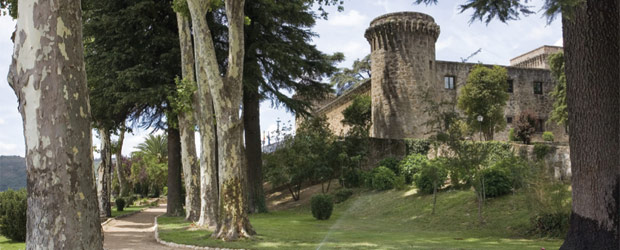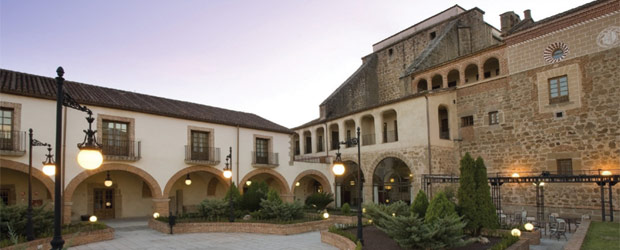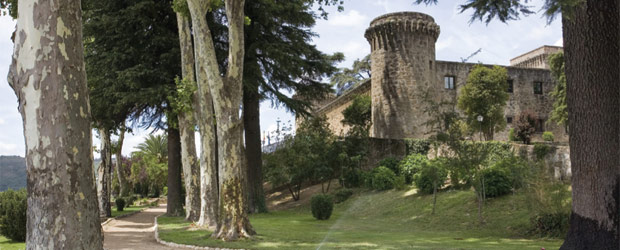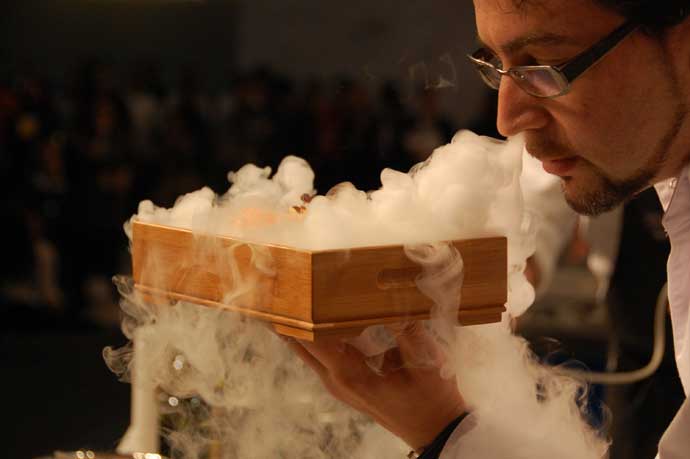Translated By: M. Alexandria Cintrano – CELTA TEFL and published journalist
Hotel InterContinental Madrid – An everlasting and growing five star luxury hotel and our privileged proposal regarding the 21st millennium.
HISTORICAL FACTS
The Hotel InterContinental Madrid is profoundly steeped in history. In the 18th century, the property was purchased by Marqués de Mérito and he had the palace reconstructed as a spectacular palatial estate. Implementing his ideas, D. Luis Feluchi decided at the end of the 1940s to keep and maintain the chimney and fireplace in the meeting room, TOLEDO, which is made of Carrara marble. You can still find the doors and LA PLACITA, the entrance for horse drawn carriages, also in their original forms.
Pointing out the main characteristics of the impeccable building, the elaborately sculptured frieze in the ALBÉNIZ MEETING ROOM, created by sculptor Don José Planes as well as the floor and the marble limestone columns in this conference room and also the main lobby. The artworks are complimented by decorative elements such as the watercolors signed by Don José Caballero, Don Antonio Arias and Don Álvaro Delgado. Furthermore, inside the building you can relax in its´ magnificent garden where you shall also find a waterfall and the fountain built by sculptor Don Ángel Ferrant.
THE 1950’s
The Intercontinental Hotel Madrid had begun to become very popular in the early 1950s for the Hollywood stars and established itself as the first international hotel in Madrid. It was the foreign residence of many renowned artists during the 1950s film shoots, for example: Ava Gardner, Frank Sinatra and Elizabeth Taylor. Additionally, chosen by many other well known performing artists including, Mia Farrow who made the hotel her home while abroad, the glorious Zsa Zsa Gabor, Sophia Loren, Gina Lollobrigida, Tony Curtis, Robert Mitchum, Luis Mariano, Gary Cooper and Charleston Heston. The 3 day opening festivities took place at the same time the United States of America, Spain and the city of Madrid signed a contract for the Madrid establishment to be the place in which performers and artists would have their very own Madrid meeting point. It had become the headquarters of Hollywood´s fashionable and the elite.
[slideshow id=35 float=center]
OVERVIEW & GENERAL INFORMATION
The prestigious Hotel Inter Continental is a 5 star luxury hotel with one of the highest brand ratings for its´reputation without leaving out a single detail and catering to the luxury lifestyle in Madrid. Situated in Madrid´s Financial District in the cultural heart of the Capital, Paseo de La Castellana, it offers impeccable services and facilities to satisfy and fulfill all the wishes of our guests. The technology in our rooms and suites, meeting rooms and public areas are state of the art. Here, you can find the spectacular lobby, the central rotunda, with an elegantly luminious dome ceiling and a wonderful view of the splendid garden. It is a breathtakingly beautiful location to enjoy a coffee, tea or wine and / or meet up with friends and business associates. One can also relax in the Bar 49, El Café, and / or the hotel´s first class preferred Restaurant, El Jardín which specialises in Mediterranean cuisine and the delicacies of the traditional and modern Capital of Madrid.
EXPLORING THE AREA
-
Paseo del Arte ( Madrid´s Art Triangle ) consisting of the Museum Prado, The Thyssen Bornemisza Museum and The Reina Sofia Museum
-
Serrano Street Shopping Mile and Barrio Salamanca Retailers within walking distance
-
Madrid´s ultra vanguard Barajas Airport is only 11 kilometres and a short drive through the Maria Molina tunnel
-
The Underground Metro line number 8 called Nuevos Ministerios leads our visitors directly to Barajas Airport
-
NEW CONVENIENCE : Our Airport Shuttle with an Eco Friendly hybrid Lexus model car is available for our guests
ROOMS & SUITES, SERVICE & EQUIPMENT FOR EVERY GUEST TYPE
The four new Presidential suites and the Royal Suite have been incorporated into this Madrid based establishment and thus, it is a unique offer for luxury accommodation compatible to the cosmopolitan style of this Capital and fashionably glamourous city.
At present, the hotel contains 302 rooms due to the latest suites. You can find 141 Superior rooms, 29 Executive rooms, 99 Club rooms, 18 Suites, 7 Ambassador suites, 7 Presidential suites and one Royal Suite to enjoy your stay with us. Additionally, there are 5 non-smoking floors.
GUEST SERVICES
Laundry, Vale service, air conditioning and heating with individual control, T.V. satellite, pay T.V. possible, AM / FM radio, alarm clock, telephone, answering machine, Minibar, smoke detectors, hair dryer, bathrobe and a security safe for your valuables and especially created for your laptop or netbook.
SECURITY
There are smoke detectors in the common and private areas throughout the hotel, fire estinguishers in the public areas, rooms and meeting rooms and Emergency lighting in the Public areas. Information about emergencies and the Emergency Plan for evacuation routes are located inside the rooms and in all public areas. There is 24 hour security and Camera Surveillance in the public areas and last but not least, First Aid.
NEW INTERCONTINENTAL SUITES & THE CROWN JEWEL, OUR ROYAL SUITE
The most challenging project was to design the spacious Royal Suite and at the same time, to enhance the inventory of the existing rooms. Enjoying the Suite on the 8th floor, one can relax in the 2 bedroom suite with living room, 3 bathrooms, private elevator, lounge, dining room and the gourmet dream kitchenette measuring 400m2. The most significant location in this stunning suite is the 180m2 exterior terrace, where one can take in the phenomenal
panoramic views of the famed Paseo de La Castellana and beyond.
CLUB INTERCONTINENTAL – A glamourous 5 star Luxury Hotel
Exclusively reserved for our executive clients at our Hotel:
Permanent breakfast Buffet 7.00am – 11.00am
Excellent personalized client services
Express Check-In and Check-Out
Breakfast: Elective in the Club Lounge, main restaurant´s premises and or as room service ( Continental Style Breakfast )
Daily national and international newspapers
Gastronomy: Buffet with a wonderful selection of dishes
Free High Speed Internet Access during your stay
Exclusively designed rooms for our Inter Continental guests with a professional coffee corner, fully equipped bathroom and the newest state of the art Technology
Daily fresh water and fruits in the rooms
Escorted invitations
Personal concierge services
Miscellaneous: Fax and photo-copy services and personal executive secretarial services on request and against payment
Baby-sitting services
Car Rental Services
An assorted pillow carte a to z
MEETING ROOMS
All 17 meeting rooms illuminate Madrid´s lovely natural daylight. Three of them are adequate for private lunches. ( Cibeles, Neptuno and Madrid Meeting Rooms ).
Special Conditions: The Albéniz Ballroom has the highest ceiling in all of Madrid´s hotels and is very appropriate for Banquets and all types of conventions and events.
GASTRONOMY
RESTAURANT EL JARDIN DEL INTERCONTINENTAL
Open daily from 13.00 hours to 16.00 hours and from 20.00 hours to 23.00 hours
Average price: 55 – 60 Euros
Daily Menu from Monday through Friday for 38.00 Euros per person
Open Air Summer Terrace
Head Chef: José Luque Torres
Epicurism: Both International and Mediterranean cuisines and the national dish of Spain, called Cocido Madrileño ( pot au fè signifying Dutch Oven on the fire, a cocoction of slow cooking on the flame and / or Madrid Stew ).
EXCLUSIVE EVENTS
It is the perfect locations to celebrate your family and commercial events. Our reliable and highly qualified team assist you during your event and caringly solve all your problems you may encounter, immediately.
SPECIAL WEDDING OFFERS
We are delighted to plan your wedding in every detail with the newsest technology and all the services you require on your special day. We have several facilities suited to your individualised needs.
BRUNCH EVERY SUNDAY UNTIL 13.30 HOURS
Available every Sunday of the year from 13.30 hours to 16.30 Hours
Open Buffet with more than 200 referenced products and an international variety of pastries, cheeses, salads, pastas, seafood, sushi, small desserts, cakes and our Chocolate Fountain
National and international specialties
Sushi prepared with Saki
Live music to suit all tastes and ages
Animation for children with clowns and games in a special area from 14.30 hours to 16.30 hours
The price of 58 Euros per person without beverages
Discounts for children 0 to 4 years: Gratis
Discount for children 5 to 12 years of age: 12.25 Euros per child
Sparkling white wine as a welcome aperitif and fresh squeezed orange juice for the children
Sophisticated yet family oriented atmosphere. Perfect to enjoy a nice Sunday especially for couples, friends and family.
Taking the courage of a Great Company, The InterContinental Hotel Group, with more than 60 years of experience, the renowned hotel brand, InterContinental Hotels & Resorts has established more than 150 hotels in up to 60 countries worldwide. We, the InterContinental believe that excellent service, quality and emphasizing its most important element, the guest, and to insure the interests of the clients. Our desire is to help our distinguished guests to benefit from every moment of their stay. Independent of the destination one selects, our aim is to create a new lifestyle in the luxury hotel segment. We wish to share our knowledge with you so that you can experience an extraordinaire and memorable stay which brightens up your life and opens your horizons. Online InterContinental allocates more information and the availability of online booking.
On www.ichotelsgroup.com . You can find all the information about our various locations and on www.priorityclub.com , you shall be informed about our Priority Club Rewards and Benefits Programme.
To be up-dated on the latest news of the InterContinental Hotel Group visit:
www. Ihgpic.com






